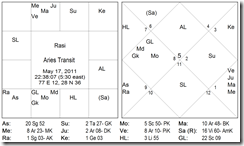While the Sun has transited out of Aries and into Taurus, the nodal shift, contrary to the belief held by those who adhere to the true position of the Nodes, has not yet occurred. This piece is being composed in the second fortnight of the month of May, 2011.
All of Jupiter/ Guru, Venus/ Shukra, Mercury/ Budh and Mars/ Mangal are in siderial Aries/ Mesha at this time.
Aries is the first sign of the zodiac and governs the head. It indicates rulership, initiative and drive. Ambition, sharpness and aggression come from this sign ruled by Mars. The host of planetary forces in this sign show the effects of all these energies leading to an initiation of fresh plans and ambitions. There is a huge blessing due to the joining of the three benefics in this ign and even the lord Mars is at work in its Moolatrikona sign where its logical acumen is sharpened.
The transit Moon is debilitated in Scorpio/ Vrishchik and thus the emotions and feelings are frayed with repressed anger and violence. Emotions are swirling at a depth and are not able to find release. It is only for those who are accustomed to the depths of the mind and do not become startled at these changes, that such Gochar does not have a deleterious impact at the outset.
The Moon is completely battered as on 17th May, 2011 due to the Graha Drishti/ planetary aspect of Shani/ Saturn and also the malefic aspect of Mangal/ Mars from Aries. Further, the Sun also aspects the Moon. For those who have such Karma to face yet this could bring a notable sense of melancholy and exclusion to the mind along with irritability and anger.
Many people have said the Moon is conjoined Rahu in Scorpio but such is not the case because the Nodes are yet to change signs. Karma is certainly at a crucial juncture because the nodes are in Gandanta, at the junction of the fire and water signs and therefore this adds to what is happening at this time.
Saturn is retrograde and therefore it has to fulfil its agenda, depending on what it is for each nativity. It could well be a work-related situation driven by self-interest and the survival instinct or something designed for pragmatic self-betterment with ponderous calculations. It could be anything involving the significations of Saturn. So too, the impact of Mars can be worked out.
However, what is of great importance is that the setting in which all this occurs is not at all adverse due to the sign aspects of the great benefics to the Moon from Aries. Only rashness and anger may be avoided.
Much depends on where Aries and Scorpio fall in a given nativity.
The effect of the benefics gives learning, knowledge, wisdom, erudition, an eye for detail, luxurious settings and such significations.

Comments
Post a Comment